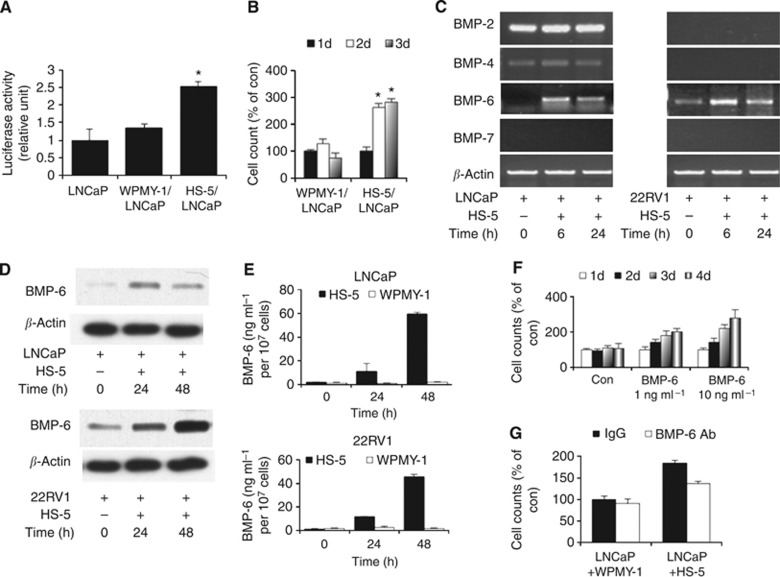Figure 1.
Recapitulation of bone and CaP interaction in vitro and expression of BMP-6. (A) LNCaP, an androgen-sensitive human CaP cell line, was transiently transfected with the androgen-responsive reporter, PSA-Lux and co-cultured with either WPMY-1 (human prostate stromal cell line) or HS-5 (human bone stromal cell line). Luciferase activity was significantly higher in LNCaP/HS-5 than in LNCaP/WPMY-1 when cultured under androgen-deprived condition (RPMI-1640 with 1% charcoal-stripped serum and 10 μM bicalutamide) (P<0.05). (B) Cell count also increased when LNCaP and 22Rv1 were co-cultured with HS-5 but not WPMY-1 in androgen-depleted condition. (C) Semi-quantitative RT–PCR for BMP-2, -4, -6, and -7 in androgen-sensitive human CaP cell lines, LNCaP and 22RV1, after co-culturing with HS-5. Only BMP-6 expression was induced in both LNCaP and 22RV1 cells. (D) Immunoblot analysis for BMP-6. Again, co-culturing with HS-5 increased the expression of BMP-6 in LNCaP and 22RV1. (E). ELISA demonstrated a dramatic increase in BMP-6 in conditioned media of LNCaP and 22Rv1 co-cultured with HS-5. (F). Direct effect of BMP-6 on cell growth under androgen-deprived condition in LNCaP. Bone morphogenetic protein-6 increased cellular proliferation of LNCaP cells in androgen-deprived condition in a time- and concentration-dependent manner. (G). Neutralisation of BMP-6 in LNCaP/HS-5 co-culture. LNCaP/HS-5 was co-cultured in the presence of BMP-6 neutralising antibody. The increase in LNCaP cell count was partially abrogated with BMP-6 neutralising antibody. *, statistically significant (P<0.01).

